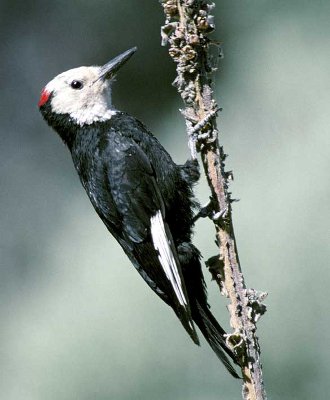White-headed Woodpecker
Category: Woodpeckers

Facts about White-headed Woodpeckers, "Scientific name for White-headed Woodpecker is Picoides albolarvatus". White-headed Woodpecker is a Picoides type of woodpecker that comes from the Picidae family. The White-headed Woodpeckers are native to North America, and they mostly live in the pine woodlands of the far western mountains where they make a livelihood by digging into closed pine cones and consuming the seeds. The White-headed Woodpecker is the only bird of North America that has a black-colored body and a white-colored head. The collection of the White-headed Woodpeckers extends into the mountains, ranging from British Columbia in the course of southern California. The White-headed Woodpecker construct nests in deceased trees or snags and reproduce once in a year. The White-headed Woodpeckers can be seen only in the montane coniferous woodlands of the west coastline of North America.
The White-headed Woodpecker is named for its white-colored head, crown and throat that contrast with the entire black body, with a white-colored wing patch. Adult male White-headed Woodpeckers have a red mark on the back part of their head between the black of the nape and the white crown. Juveniles as well, boast a white-colored head with varying amounts of red patch on the back of their head, a duller black-colored body, and sparser white-colored wing patches. Both genders offer a call all through the year that can be mixed together with drumming, containing an even roll of 15 to 30 beats in 0.5 to 1.5 seconds.
Both the female and male White-headed Woodpeckers protect the eggs, with the male bird carrying out all the nocturnal work. The White-headed Woodpecker are extremely helpful to each other at the time of incubation, and habitually correspond through soft drumming from both outside and inside the nest hole.
Diet
Mostly, White-headed Woodpeckers feed on conifer seeds and insects.
The average lifespan of the White-headed Woodpecker ranges from 10 years to 15 years.
When feeding, drumming and building a nest cavity, a White-headed Woodpecker can peck up to 20 times per second, wow that's fast! or a total between 9,000 and 12,000 pecks in a day.
White-headed Woodpeckers have a prominent surge in flight comprise of three rapid wing flaps, followed by a quick glide when the White-headed Woodpeckers wings are tucked against its body rather than spread out like many other birds.
Scientific name for Woodpecker "Picidae". White-headed Woodpeckers are birds in the Class of "Aves". There are more than 190 species of woodpeckers worldwide, but none of them are found in polar regions, Madagascar, New Zealand or Australia.
White-headed Woodpeckers have zygodactyl feet, having 4 fingers, which means they have two toes facing the front and two toes facing the back, that helps the White-headed Woodpecker to have a strong grip on trees vertically. The White-headed Woodpecker use these 8 fingers with their stiff central portion tail feathers to brace on trees as they climb.
Features
The White-headed Woodpecker is an average-sized bird, with a body length, ranging from 8 5/16 inches to 9 1/8 inches (21 to 4.1 cm), with a body mass that ranges from 1.9 pounds to 2.3 pounds (.86 to 1 kg).
The White-headed Woodpecker has an outstanding black color body, with a white-colored head that makes the bird distinguishable easily from other woodpeckers all through its range. The White-headed Woodpecker is restricted by suitable home, defined by huge pine trees that have big cones and seeds for nourishing and snags for nesting holes, which is endangered by contemporary forestry practices.
Male and female White-headed Woodpeckers are able to drum hollow trees logs execrate. Since White-headed Woodpeckers do not have vocal cords and don't sing, this pecking activity also plays an important role in communicating with each other. White-headed Woodpeckers drumming is also to attract a mate, mark out territory, both sexes are known to drum.
An average White-headed Woodpeckers tongue is up to 4 inches long. The length can be a little different depending on which species of woodpecker. White-headed Woodpeckers tongue wraps around the reinforced skull structured and squashy bone, to even out the impact of the pecking force. White-headed Woodpeckers have barbed tongues that helps them remove bugs from holes and tree bark.
Feathers that look like hairs on the White-headed Woodpecker nostrils, prevent ingestion of wood particles.
White-headed Woodpeckers are omnivores; meaning - an animal that eats food of both animal and plant and origin.
White-headed Woodpeckers possess a protective ocular mechanisms for protecting its eyes from shaking from the pecking impact. White-headed Woodpeckers show a restricted axial globe movement due to the tight fit within the fascial tissue connections and orbit between the sclera and orbital rim.
The eyes of the White-headed Woodpecker are covered with a nictitating membrane (from Latin nictare, to blink)— a translucent and transparent third eyelid - that protects the White-headed Woodpeckers eyes from flying debris while pecking.
White-headed Woodpeckers are monogamous meaning- the pair will mate for lifetime. Both male and female White-headed Woodpecker prepare the nest in the tree for babies and both will help feed them. The female will lay between 3 and 5 eggs and the incubation period will lasts 11 to 14 days. After one month of hatching, young White-headed Woodpeckers will leave the nest and venture out on there own.

 Back To Category Woodpeckers
Back To Category Woodpeckers